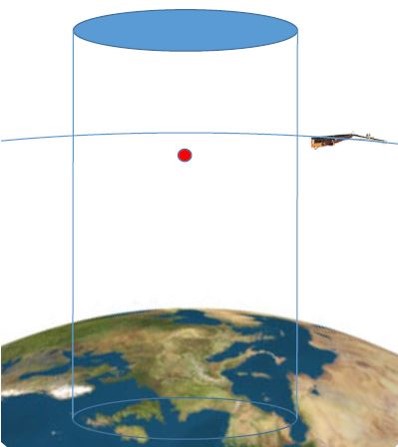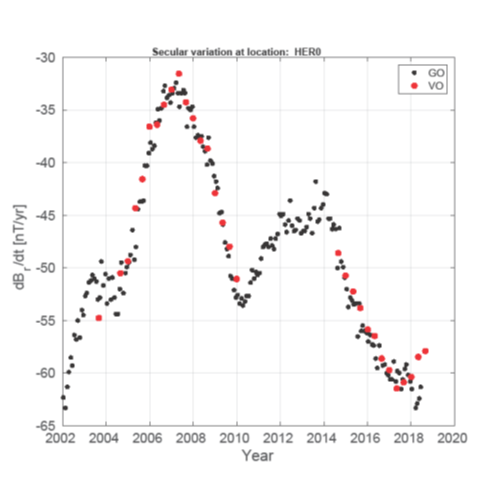Geomagnetic Virtual Observatories
In collaboration with Danish Technical University (DTU Space), BGS completed a contract from the European Space Agency to produce a Swarm product called Geomagnetic Virtual Observatories (GVO).
Unlike ground observatories, which are stationary, the three Swarm magnetic satellites move at around 8 km/second and only revisits the same location on the surface once every 4 months. This makes it difficult to directly compare satellite and ground observatory data. To overcome this, we intend to create a set of 'virtual observatories' in space (Mandea and Olsen, 2006; Beggan et al., 2008).
These are created in three steps. First, we collect all the satellite data that pass within 700 km of an defined point in space (at 400 km) [Figure 1]. We do this for 300 points on an equal area grid across the globe. Secondly, we subtract off the core field and find the robust 'average' of the residuals (Barrois et al., 2018). Finally, we add back on the core field to get the magnetic field vector at each virtual observatory.
If we place a GVO over a ground observatory, the comparison between the rate of change of the magnetic field (so-called secular variation) is excellent. Figure 2 shows an example for the Hermanus observatory in South Africa.
However, GVO data are not perfect and often contain contamination from the ionosphere and magnetosphere, so there are further processing steps to extract the purely core field signal using Principal Component Analysis (Cox et al., 2018).
The final product for ESA consists of several GVO grids with various levels of processing and cleaning applied to them. These are useful for researchers studying the dynamics of the outer core (e.g. fluid flow or secular acceleration).
The project kicked off in June 2019 and completed in June 2020. The first official GVO products were released in February 2021 and will be updated on a four-monthly cycle . They are described in detail in Hammer et al. (2021). Further information, example code and project documentation are available at the DTU Space GVO webpage .
Contact
For more information please contact Dr Ciaran Beggan.
References/Further reading
- Hammer, M. D.; Cox, G. A.; Brown, W. J. ; Beggan, C. D. and C. C. Finlay, (2021), Geomagnetic Virtual Observatories: monitoring geomagnetic secular variation with the Swarm satellites. Earth, Planets and Space, 73 (54). https://doi.org/10.1186/s40623-021-01357-9
- Barrois, O., M. D. Hammer, C. C. Finlay, Y. Martin and N. Gillet, (2018) Assimilation of ground and satellite magnetic measurements: inference of core surface magnetic and velocity field changes, Geophysical Journal International, 215 (1), 695-712, doi:10.1093/gji/ggy297
- Cox, G. A., Brown, W. J., Billingham, L., & R. Holme (2018), MagPySV: A Python package for processing and denoising geomagnetic observatory data. Geochemistry, Geophysics, Geosystems, 19, 3347-3363. doi:10.1029/2018GC007714
- Beggan, C. D., K. A. Whaler and S. Macmillan (2009), Biased residuals of core flow models from satellite-derived 'virtual observatories', Geophysical Journal International, Volume 177 (2), 463-475, doi:10.1111/j.1365-246X.2009.04111.x
- Mandea, M., and N. Olsen (2006), A new approach to directly determine the secular variation from magnetic satellite observations, Geophys. Res. Lett., 33, L15306, doi:10.1029/2006GL026616.

- Global Geomagnetic Models
- Space Weather and Geomagnetic Hazard
- High-frequency magnetometers
- Schumann Resonances
- Geoelectric field monitoring
- Space Weather Impact on Ground-based Systems (SWIGS)
- SWIMMR Activities in Ground Effects (SAGE)
- Geomagnetic Virtual Observatories
- Quantum magnetometers for space weather
- Magnetotellurics
- Publications List


